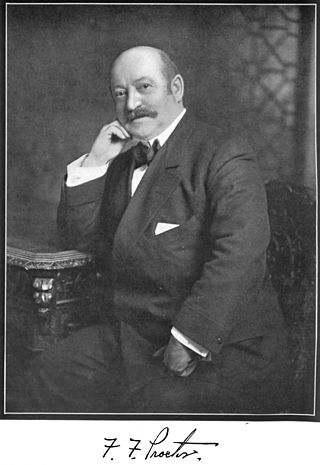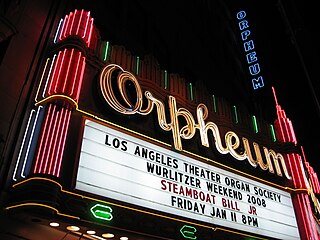
The Tennessee Theatre is a movie palace in downtown Knoxville, Tennessee. The theater was built in 1928 in the 1908 Burwell Building, considered Knoxville's first skyscraper. The theater and Burwell Building were added to the National Register of Historic Places in 1982, and the theater was extensively restored in the early 2000s. The Tennessee Theatre currently focuses on hosting performing arts events and classic films, and is home to the Knoxville Opera and the Knoxville Symphony Orchestra. The theater is managed by AC Entertainment.

Thomas White Lamb was a Scottish-born, American architect. He was one of the foremost designers of theaters and cinemas in the 20th century.

Playhouse Square is a theater district in downtown Cleveland, Ohio, United States. It is the largest performing arts center in the US outside of New York City. Constructed in a span of 19 months in the early 1920s, the theaters were subsequently closed down, but were revived through a grassroots effort. Their renovation and reopening helped usher in a new era of downtown revitalization in Cleveland, and was called "one of the top ten successes in Cleveland history."

The Palace Theatre is a Broadway theater at 1564 Broadway, facing Times Square, in the Midtown Manhattan neighborhood of New York City. Designed by Milwaukee architects Kirchhoff & Rose, the theater was funded by Martin Beck and opened in 1913. From its opening to about 1929, the Palace was considered among vaudeville performers as the flagship of Benjamin Franklin Keith and Edward Franklin Albee II's organization. The theater had 1,743 seats across three levels as of 2018.

The LeVeque Tower is a 47-story skyscraper in Downtown Columbus, Ohio. At 555 feet 5 inches (169.29 m) it was the tallest building in the city from its completion in 1927 to 1974, and remains the second-tallest today.

The Ohio Theatre is a performing arts center and former movie palace on Capitol Square in Downtown Columbus, Ohio. Known as the "Official Theatre of the State of Ohio", the 1928 building was saved from demolition in 1969 and was later completely restored. The theater was declared a National Historic Landmark in 1977 as one of the nation's finest surviving grand theaters.

Charles Howard Crane was an American architect who was primarily active in Detroit, Michigan. His designs include Detroit's Fox Theatre and Olympia Stadium, as well as LeVeque Tower in Columbus, Ohio, which remains that city's second tallest building.

State Theatre New Jersey is a nonprofit theater, located in New Brunswick, New Jersey. It has seating for 1,850 people. Designed by architect Thomas W. Lamb in 1921, it is one of the oldest theaters in the State of New Jersey.

Frederick Freeman Proctor, aka F. F. Proctor, was a vaudeville impresario who pioneered the method of continuous vaudeville. He opened the Twenty-third Street Theatre in New York City.

The Paramount Theatre was a 3,664-seat movie palace located at 43rd Street and Broadway on Times Square in New York City. Opened in 1926, it was a showcase theatre and the New York headquarters of Paramount Pictures. Adolph Zukor, founder of Paramount predecessor Famous Players Film Company, maintained an office in the building until his death in 1976. The Paramount Theatre eventually became a popular live performance venue. The theater was closed in 1964 and its space converted to office and retail use. The tower which housed it, known as the Paramount Building at 1501 Broadway, is in commercial use as an office building and is still home to Paramount Pictures offices.

Keith-Albee Theatre is a performing arts center located along Fourth Avenue in downtown Huntington, West Virginia, United States. The Keith-Albee was named after the Keith-Albee-Orpheum Corporation, one of the leading vaudeville performance chains at that time, to convince the directors of Keith-Albee-Orpheum to make the Keith-Albee a regular stop. At the time of its construction, The Keith Albee was the second largest theater in the U.S. It is listed on the National Register of Historic Places as part of the Downtown Huntington Historic District, and is currently being restored as a performing arts center.

The Orpheum Theatre, a 2,308-seat venue listed on the National Register of Historic Places, is located in downtown Memphis, Tennessee, on the southwest corner of the intersection of South Main and Beale streets. The Orpheum, along with the Halloran Centre for Performing Arts & Education, compose the Orpheum Theatre Group, a community-supported nonprofit corporation that operates and maintains the venues and presents education programs.

An atmospheric theatre is a type of movie palace design which was popular in the late 1920s. Atmospheric theatres were designed and decorated to evoke the feeling of a particular time and place for patrons, through the use of projectors, architectural elements and ornamentation that evoked a sense of being outdoors. This was intended to make the patron a more active participant in the setting.

The Hippodrome Theatre is a theater in Baltimore, Maryland.

The Great Southern Hotel & Theatre is an historic hotel and theater building in Downtown Columbus, Ohio. The building currently operates as the Westin Great Southern Columbus and the Southern Theatre.

The Boston Opera House, also known as the Citizens Bank Opera House, is a performing arts and esports venue located at 539 Washington St. in Boston, Massachusetts. It was originally built as the B.F. Keith Memorial Theatre, a movie palace in the Keith-Albee chain. The chain became part of RKO when it was established just before the theater opened on October 29, 1928, and it was also known as the RKO Keith's Theater. After operating for more than 50 years as a movie theater, it was rededicated in 1980 as a home for the Opera Company of Boston, which performed there until the opera company closed down in 1990 due to financial problems. The theater was reopened in 2004 after a major restoration, and it currently serves as the home of the Boston Ballet and also hosts touring Broadway shows.

The RKO Keith's Theater was an RKO Pictures movie theater at 129-43 Northern Boulevard in the Flushing neighborhood of Queens in New York City. It was designed by architect Thomas W. Lamb and built in 1928. While the RKO Keith's had a plain three-story facade, its interior was elaborately designed in a Spanish Baroque Revival style. The theater had a square ticket lobby and an oval grand foyer, which led to the double-level auditorium. The auditorium was designed as an atmospheric theater with a blue ceiling and gilded-plaster decorations; it contained 2,974 seats across two levels. There were also four lounges and a mezzanine promenade.
The RKO Boston Theatre was a movie theatre in Boston, Massachusetts, located at 616 Washington Street, near Essex Street in the Boston Theater District. It opened as the Keith-Albee Boston Theatre on October 5, 1925.

The Orpheum Circuit was a chain of vaudeville and movie theaters. It was founded in 1886, and operated through 1927 when it was merged into the Keith-Albee-Orpheum corporation, ultimately becoming part of the Radio-Keith-Orpheum (RKO) corporation.

The Marion Palace Theatre is a movie palace constructed in 1928 in Marion, Ohio, United States for the Young Amusement Company. The original cost of the project was $500,000. It is listed on the National Register of Historic Places because of its significance to the atmospheric theatre architectural style popular in the United States during the 1920s.






















